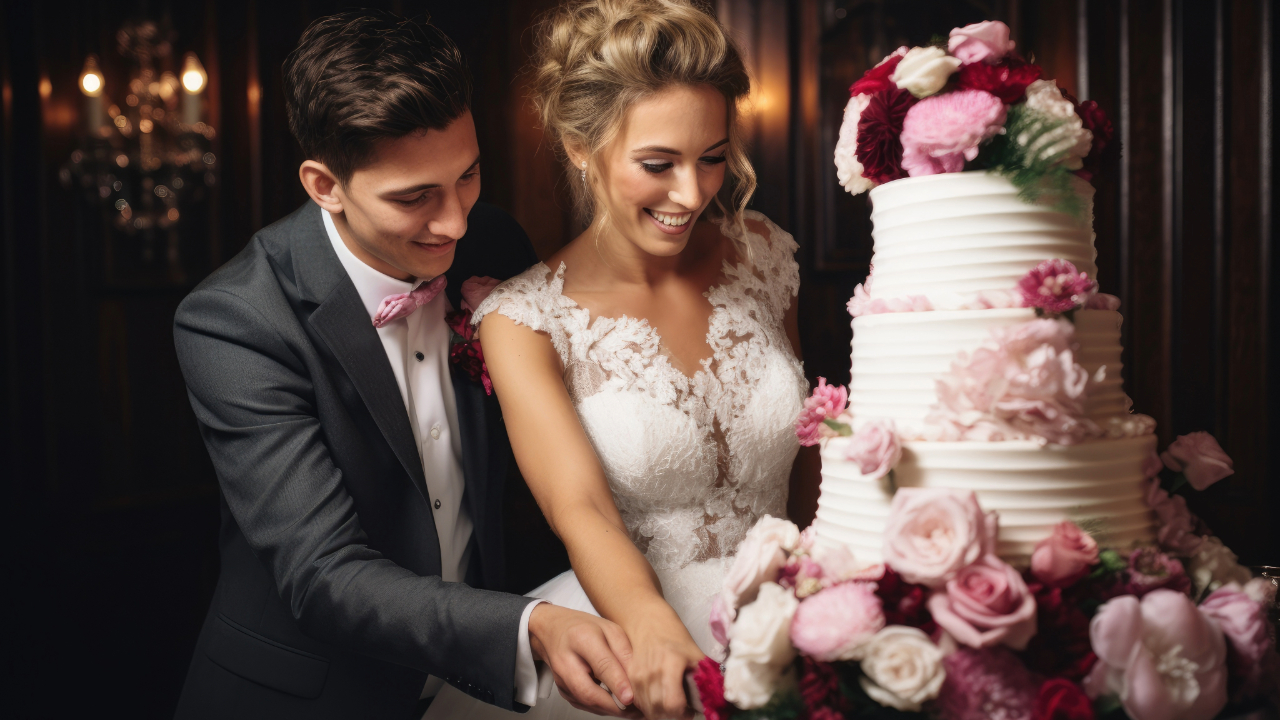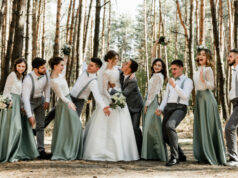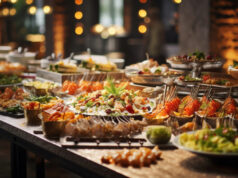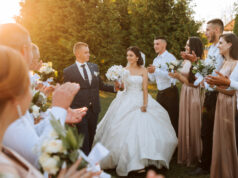Hey there, soon-to-be newly-weds! As you dive into the whirlwind of wedding planning, let’s talk about one of the most iconic—and delicious—moments of your big day: the wedding cake cutting ceremony. This isn’t just about indulging in a scrumptious slice of cake (although, let’s be honest, that’s a pretty sweet part of it); it’s a rich tradition packed with symbolism and shared joy. From the ancient streets of Rome to your contemporary wedding venue, this tradition has evolved into a heart-warming highlight of wedding celebrations. So, grab a fork (or just your imagination for now), and let’s explore the history, cultural twists, and all the fun etiquette that comes with cutting your wedding cake.
Whether you’re dreaming of a classic multi-tiered masterpiece or a unique twist that reflects your personal story, this guide is here to help you plan a cake cutting ceremony that’s as unique and memorable as your love story. Let’s make your wedding cake moment truly a slice of happiness!
▶️ You may like: Wedding catering in Europe, where to start?
The history and symbolism of the wedding cake
The wedding cake, more than just a delightful dessert, is a symbol steeped in history and rich in meaning. Tracing its origins back to ancient Rome, wedding cakes were initially simple wheat-based creations, served as symbols of fertility and prosperity. Imagine guests at Roman weddings breaking a cake over the bride’s head, hoping to bless the couple with abundance and a fruitful union.
This tradition evolved through the ages, becoming sweeter and more ornate as sugar became more accessible during the Middle Ages. The cake’s design, inspired by the spire of a church, saw couples kissing over its towering height, a gesture symbolizing their union and the hope for a blissful future together.
By the 18th century, the wedding cake we recognize today began to take shape with the introduction of white icing, a nod to the Victorian era’s values of purity and elegance. The white cake not only became a status symbol—reflecting the social standing and wealth of the family—but also a visual representation of the bride, highlighting her as the centrepiece of the wedding. Over time, as cakes became more elaborate and multi-tiered, the act of cutting the cake evolved into a shared task between bride and groom, symbolizing their first collaborative act and mutual support in their new life together.
This shared slice, a moment of commitment and love, is savoured by couples around the world, continuing the enduring legacy of the wedding cake as a symbol of joy, unity, and the sweet journey of married life ahead.
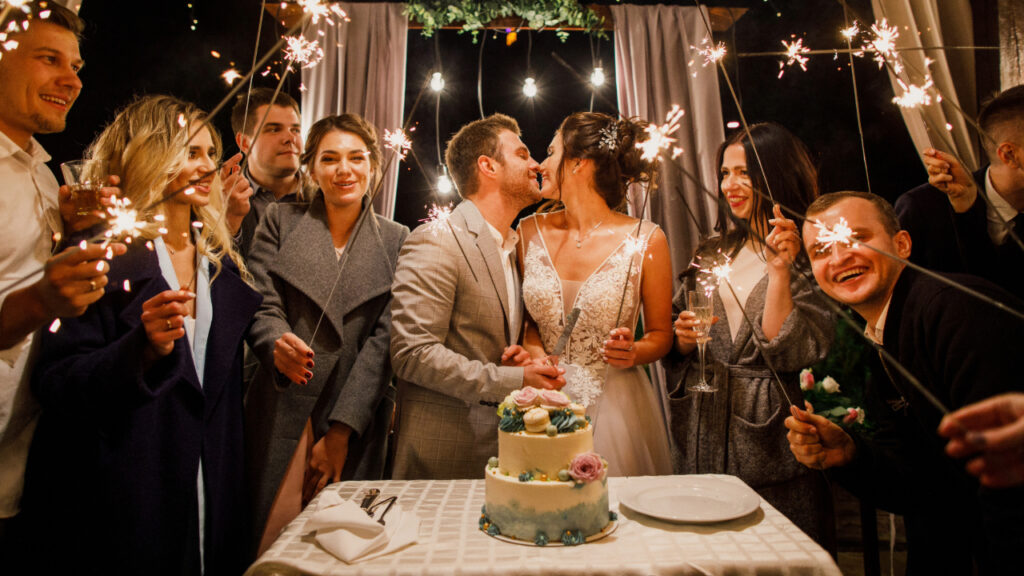
A little diversion into some European traditions
European wedding cake traditions are as varied and rich as the continent itself, each country adding its unique flavour to this sweet aspect of matrimony.
In Italy, the concept of the wedding cake takes on a delectable twist with Millefoglie, a delightful confection made from layers of light puff pastry, sumptuously filled with custard cream and fresh fruits. This choice reflects the Italian penchant for elegance and simplicity, a departure from the more common multi-tiered cakes. It’s a sweet embodiment of La Dolce Vita, the good life, that is at the heart of Italian celebrations.
Moving north to Germany, we encounter a different tradition that centres around strength and unity. Here, couples may partake in the curious practice of sawing a log together after their wedding ceremony. This custom isn’t directly related to the cake itself, but it complements the cake cutting ceremony by symbolizing the first major challenge the couple overcomes together, much like the joint effort of cutting a wedding cake. It’s a powerful metaphor for teamwork and the joint efforts required in marriage.
In France, the wedding cake tradition is often embodied by the elegant and sophisticated « croquembouche », a stunning confection that deviates from the typical multi-tiered wedding cakes seen in many other cultures. The croquembouche is a tower of profiteroles—small, cream-filled choux pastries—meticulously piled into a cone and bound together with threads of caramel.
▶️ Read also: Budgeting for your dream wedding in France
The croquembouche’s towering structure symbolizes the challenges and joys that the couple will encounter in their married life, with each profiterole representing a moment or experience they will share. Cutting into the croquembouche, often done with a small hammer or by hand rather than a knife, is a playful and joyful act that reflects the celebratory spirit of French weddings.
Slicing into Love: The heart-warming tradition of the wedding cake cutting ceremony
The cake cutting ceremony, often eagerly anticipated by the guests, represents the first joint act of the bride and groom as a married couple, symbolizing their union and shared future. Traditionally, the bride, with the groom’s assistance, makes the first cut. This custom dates back to when the bride alone was responsible for cutting and distributing the cake among guests, a nod to ancient practices where breaking bread over the bride’s head was believed to bring fertility and good fortune.
As weddings evolved into grander affairs and cakes grew in size and complexity, this task became a joint effort, reflecting the partnership and cooperation essential in marriage. The act of cutting the cake together symbolizes the couple’s mutual support and commitment to each other. It’s a poignant moment, filled with anticipation and joy, as the couple slices through the layers of the cake, a metaphor for their life ahead, layered with experiences, challenges, and shared joys.
Following the initial cut, the bride and groom typically feed each other a piece of the cake. This gesture is laden with symbolism—feeding each other signifies a commitment to provide for one another and share the bounties of life together. The manner in which the cake is shared can vary, from a tender and loving exchange to the playful (yet sometimes controversial) tradition of smashing cake into each other’s faces. Regardless of how the cake is shared, this moment is often one of the most photographed and remembered parts of the wedding, encapsulating the essence of partnership and the sweetness of the bond the couple shares.
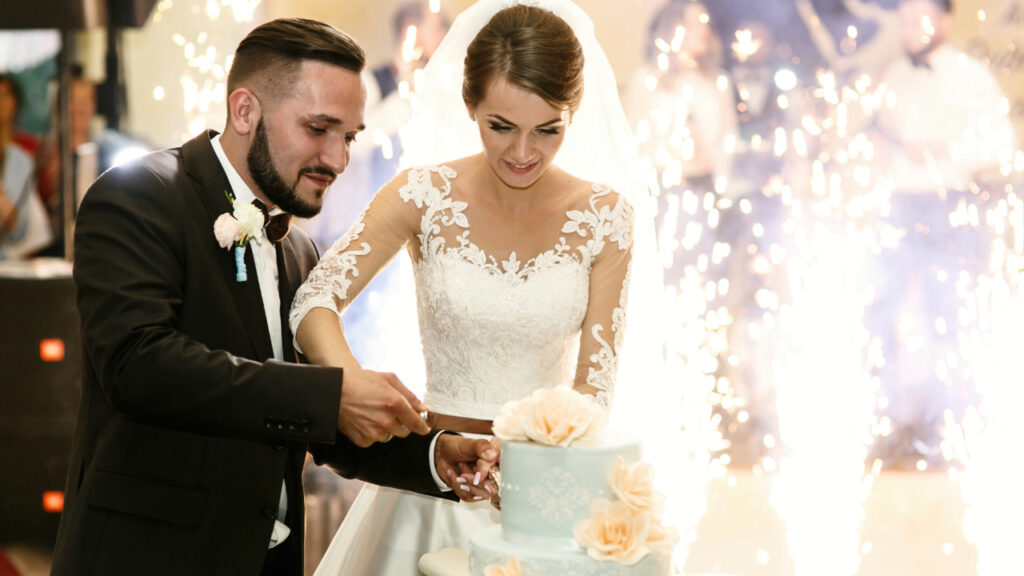
So now, how do you choose your wedding cake, and how do you cut it?
When selecting a cake, couples should consider the size, shape, and flavour that best fit their celebration. Classic options like vanilla, chocolate, and red velvet remain popular, but many couples now opt for more unique flavours or fillings that hold special meaning or cater to their culinary preferences. The cake’s design can range from simple elegance to elaborate artistry, often coordinating with the wedding’s theme or colour scheme. Shapes like round, square, heart-shaped, and even unconventional petal tiers or ovals offer a variety of choices, each with its own method of cutting for serving guests.
💡 Need a little inspiration? Here are 5 pastry chefs in Europe whose creations are truly original:
- Avant Garde Cake Studio (UK): Based in the UK, Avant Garde Cake Studio specializes in artistic wedding cakes, catering to various dietary needs with options like gluten-free, nut-free, and soy-free cakes. Their cakes are vegan and made by a Parisian baker, Sarah, who ensures a bespoke and personalized experience for each couple.
- Hebe Konditori (London, UK): Founded by London-based baker Sarah Hardy, Hebe Konditori is known for extraordinary vegan cakes. Sarah’s background in art and sculpting skills are evident in her creations, which are heavily inspired by fashion and cinematography, particularly Sophia Coppola’s Marie Antoinette film.
- Synie’s Paris (Paris, France): Located in Paris, Synie’s Paris is renowned for creating luxury wedding cakes that are both a work of art and a culinary delight. They specialize in custom-designed cakes that are not just for eating but serve as showstoppers for any wedding.
- Du Pain et des Idees (Paris, France): This Parisian bakery, « Bread and Ideas, » offers a unique approach to baking, using sourdough and artisan methods to create their products. While primarily known for bread, their approach to baking can offer a unique take on wedding cakes.
- Pasticceria Marchesi (Milan, Italy): One of the historical bakeries in Milan, Pasticceria Marchesi is famous for its chocolate, pastries, and Panettone. The 18th-century building that houses the bake shop adds to the charm, and their expertise in pastries can be translated into unique wedding cakes.
The art of cutting the cake involves more than just slicing into the tiers; it’s about creating a memorable and graceful moment. The traditional approach starts with the couple making a small incision into the cake together, symbolizing their partnership. For round cakes, couples typically cut one-inch slices from the edge, moving inwards in a spiral, while square cakes are cut in grid-like patterns. The key is to make each slice uniform in size, ensuring each guest gets a fair share of the delightful treat. T
The timing of the cake cutting is also important; it usually takes place after dinner and speeches, signalling the transition into the more relaxed part of the evening. As the couple cuts the cake, they should face their guests, allowing friends and family to share in the joy and capture the moment in photos.
Traditionally, the top tier of the cake is saved for future celebrations, such as the couple’s first anniversary or the christening of their first child. While some couples choose to playfully smash cake into each other’s faces, others prefer a more dignified approach, reflecting their personalities and the tone of their wedding.
You’ve got it: The wedding cake cutting ceremony is a cherished tradition that adds sweetness and symbolism to the wedding day. By understanding its history, embracing cultural variations, and following proper etiquette, couples can create a memorable and meaningful experience. Whether opting for a classic multi-tiered cake or a unique cultural variant, the wedding cake cutting ceremony remains a testament to love, unity, and the joyous journey of marriage. So enjoy this moment!

